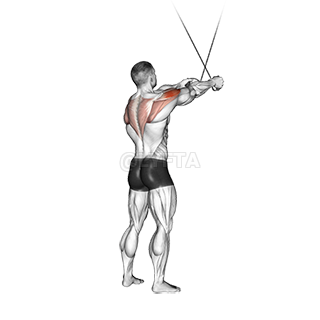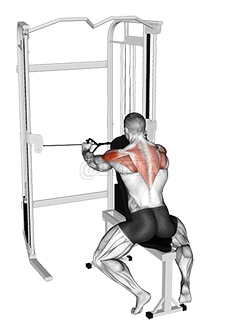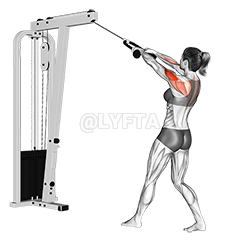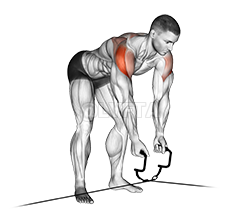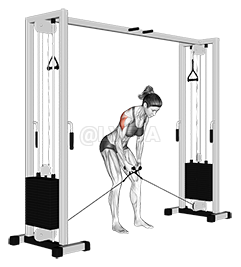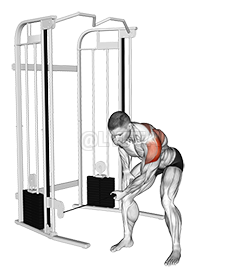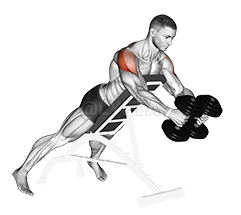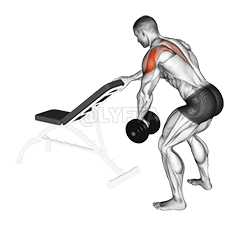
Cross-over Revers Fly
Exercise Profile
Related Exercises:
Introduction to the Cross-over Revers Fly
The Cross-over Reverse Fly is a highly effective exercise that targets the upper body, specifically strengthening the shoulders, upper back, and improving posture. It is suitable for both beginners and advanced fitness enthusiasts as it can be easily modified to match individual fitness levels. Individuals may want to incorporate this exercise into their routine to enhance their upper body strength, improve muscular balance, and aid in daily activities that require upper body functionality.
Performing the: A Step-by-Step Tutorial Cross-over Revers Fly
- Bend your knees slightly and bend over at the waist while keeping your back straight, so your torso is almost parallel to the floor.
- Extend your arms in front of you so they are perpendicular to your torso, with the weights meeting at the center.
- Keeping your arms slightly bent, open your arms to the sides (in a reverse fly) until they are parallel to the ground.
- Slowly lower the dumbbells back to the starting position in front of you, crossing one over the other, and repeat the exercise for the desired number of repetitions.
Tips for Performing Cross-over Revers Fly
- Controlled Movement: Avoid rushing through the movement. The key to this exercise is slow, controlled movement, which will engage your muscles more effectively. As you bring your arms out to the sides, squeeze your shoulder blades together, then slowly return to the starting position.
- Correct Weight: Use a weight that allows you to complete the exercise with proper form. If the weight is too heavy, you may end up using your back or other muscles to compensate, which can lead to injury. Start with a lighter weight and gradually increase as your strength improves.
- Avoid Locking Your Elbows: When performing the Cross-over Reverse Fly, avoid locking your elbows. Keeping a slight bend in your elbows
Cross-over Revers Fly FAQs
Can beginners do the Cross-over Revers Fly?
Yes, beginners can do the Cross-over Reverse Fly exercise. However, it's important to start with light weights to avoid injury and to ensure proper form. It's also recommended to have a trainer or experienced individual present to provide guidance and ensure the exercise is being done correctly. If any discomfort or pain is felt, the exercise should be stopped immediately to prevent injury.
What are common variations of the Cross-over Revers Fly?
- Seated Cross-over Reverse Fly: This variation is done while sitting, which can help isolate the shoulder muscles more effectively.
- Single Arm Cross-over Reverse Fly: This variation is performed one arm at a time, allowing you to focus on each side individually.
- Stability Ball Cross-over Reverse Fly: This variation is performed while balancing on a stability ball, which engages the core and improves balance.
- Bent Over Cross-over Reverse Fly: This variation is done in a bent-over position, targeting the rear delts and upper back muscles.
What are good complementing exercises for the Cross-over Revers Fly?
- Bent Over Rows: This exercise targets the muscles in the back, particularly the latissimus dorsi and rhomboids, which are also engaged during the Cross-over Reverse Fly, thereby increasing back strength and enhancing the effectiveness of the fly exercise.
- Shoulder Press: This exercise strengthens the deltoids and the triceps, muscles that are also engaged during the Cross-over Reverse Fly, thus improving shoulder stability and strength, which can improve performance and reduce the risk of injury during the fly exercise.
Related keywords for Cross-over Revers Fly
- Cable Cross-over Reverse Fly workout
- Shoulder strengthening exercises
- Cable machine workouts
- Reverse Fly exercise
- Cable Cross-over for shoulders
- Shoulder muscle building exercises
- Gym workouts for shoulder strength
- Cable Cross-over Reverse Fly technique
- How to do a Cross-over Reverse Fly
- Best exercises for shoulder muscles
